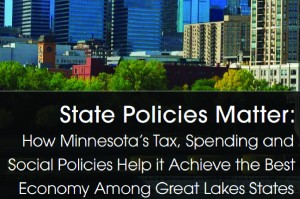Over the last eight years Michigan has experienced a strong recovery from the Great Recession. The headline being 500,000 new jobs. Good news indeed for a state ![]() that lost jobs every year during the previous decade.
that lost jobs every year during the previous decade.
As well as Michiganders have done the past eight years, Minnesotans have done better. Michigan’s employment growth has been stronger. But Minnesotans over the last eight years have seen their standard of living increase far more than Michiganders. Minnesotans work more and they earn more than Michiganders:
- Employment up 15% in Michigan, up 13% in Minnesota from 2010-17. But the employment gap between the two states is still huge. Minnesota is second in the nation in the proportion of working age adults with a job, Michigan is tied for 37th. If the same proportion of Michiganders had a job as Minnesotans there would be 725,000 more Michiganders working today.
- Average private sector hourly wage, not corrected for inflation, up $4.59 in Minnesota, up $2.38 in Michigan from 2010-2017. The gap between the two states has grown from $1.57 to $3.78. The average private sector hourly wage in Minnesota is $28.42, in Michigan it is $24.64.
- Real median household income as calculated from the Current Population Survey up nearly $13,000 in Minnesota, up nearly $5,600 in Michigan from 2010-2017. The gap has grown from about $6,800 to $14,200.
- Both states saw a reduction of about three percentage points in the proportion of households with income two times poverty (around $48,000 for a household with two adults and two children) or lower from 2010-2016. 24.3 percent of Minnesota households have income two time the federal poverty rate or less compared to 32.6 precent in Michigan. If Michigan were at the same rate as Minnesota there would be about 300,000 fewer lower-income households here today.
Many of Michigan’s political and business leaders assert that a prime reason for Michigan’s recovery is implementation of business friendly-policies. Headlined by a big business tax cut and becoming a right to work state. Minnesota did neither.
While Michigan saw its ranking in the Tax Foundation’s 2018 State Business Tax Climate Index climb to 12th, Minnesota stayed near the bottom, ranking 46th. Rather than competing to be a low-tax place, Minnesota raised taxes in 2013 to be able to stay the course that they have been pursuing for decades. A strategy to improve the economic well being of Minnesotans based primarily on public investments in education from birth through college and in the basic services, infrastructure and amenities that create communities where people want to live and work.
We detail Minnesota’s state economic policies in our State Policies Matter report. It tells a story of a state that has for decades invested more than Michigan in revenue sharing to help finance local communities; early childhood education, K–12 education and higher education to achieve the best student outcomes in the Great Lakes; health and human services; public safety; and transportation––both roads and transit.
Minnesota’s out-performance is not limited to the last eight years. Median household income in 1986 was virtually the same in the two states. No more. Real median household income in Minnesota has grown from $56,619 to $71,920 from 1986-2017. While in Michigan it has hardly grown for three decades: from $56,966 in 1986 to $57,700 in 2017.
So over three decades, no matter whether the national economy has been growing or contracting and no matter which party was in office, Minnesotans have gotten more prosperous than Michiganders. Minnesota is the Great Lakes leader on all measures of economic well being and prosperity. Minnesota is now structurally a national leader in economic well being of its residents, Michigan structurally a national laggard.
Minnesota’s economic performance is consistent with what we have learned over more than a quarter century of economic research: the states and regions with the most prosperous economies are those that combine a high-quality education system with the quality of place that retain and attract mobile talent. Both education and placemaking require public investments. These types of public investments, paid for by our taxes, are the state policy playbook most likely to return Michigan to the status it enjoyed for most of the 20th Century: one of America’s most prosperous states.







